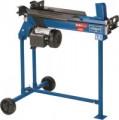Splitting force
The greatest force that the wood splitter is able to apply to the workpiece in the process of splitting.
This parameter is relevant for hydraulic and rack units (see "Type"). Even in the simplest such devices, the splitting force reaches several tons. In general, high force allows you to cope with hard and thick workpieces, however, it requires high power and strength, which significantly affects the price and weight of the entire unit. Therefore, it is worth choosing a model according to this characteristic, taking into account the specifics of the work.
So, for use in the private sector, a wood splitter with a splitting force of up
to 5 tons is considered quite sufficient, for boiler rooms and other relatively large consumers —
5-8 tons (up to 10 tons), and
more powerful devices are intended mainly for industrial use.
Max. log length
The longest log that a log splitter can handle. In fact, this is the largest distance that the stop and working nozzle can be spread; if the workpiece is longer than this distance, it will have to be sawn.
Note that this indicator significantly affects the dimensions (especially in a horizontal working position), and the force required to split a long log is quite high. Therefore, for small volumes of work (for example, when harvesting firewood for a private house), a wood splitter with a relatively small maximum length is often the best choice —
up to 60 cm ; longer workpieces can be sawn. But models of
more than 60 cm are intended mainly for work on a large scale.
Splitting speed
The time it takes for the cleaver/knife to move from the top end position to the bottom end position. The splitting speed is measured in centimeters per second (cm/s). The average wood splitter has a speed of 4 cm / s. This indicator is influenced by both the drive power and the piston stroke height. In turn, the splitting speed itself affects the performance of the wood splitter — the higher it is, the faster the device will cope with the work.
Return speed
The time it takes for the cleaver/knife to move from the lowest position to the highest position. It is measured in centimeters per second cm/s. Together with the splitting speed parameter, the return speed determines the travel time. An ordinary average wood splitter returns the cleaver to the working (upper) position in 7-8 seconds.
Oil volume (hydraulic system)
The total amount of oil that can fit into the hydraulic system of the respective log splitter (see "Type"). This parameter allows you to estimate how much oil is required for one refueling or refilling of the unit.
Max. power
Wood splitter motor power in watts. The designation in watts is used for all types of engines, which allows you to compare units with different types of motors.
A powerful motor is needed above all in order to provide a high splitting force (see above). However, when choosing, it is worth focus not so much on power, but on the force stated in the characteristics and the length / thickness of the logs. In addition, in the case of electric motors (see "Motor type"), the power directly determines the energy consumption, which is important in some situations (when running from a generator, with weak wiring, etc.)
Stand
The presence of high legs
(stands) for a horizontal wood splitter will allow you to use it when it is installed immediately on the ground, floor. There is no need to make an additional elevation in the form of a table, a workbench for more convenient feeding and chopping of small logs. But compact models of
horizontal wood splitters without a stand are of two types. The first includes ground models for chopping powerful logs, which it makes no sense to raise to a height. The second type provides wood splitters for installation on a hill, which, due to the lack of a stand, must be provided in advance. In both cases, the absence of a stand (high legs) makes the model more compact and more mobile.

